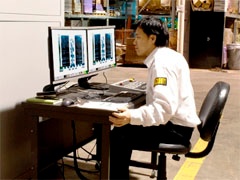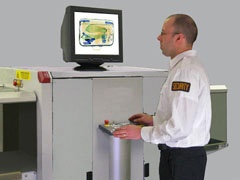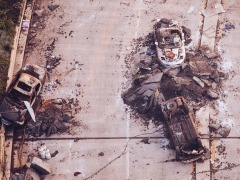Many companies rely on X-ray systems to screen items arriving at or passing through their facility. The items these security screeners typically observe varies depending on the industry and whether belongings, cargo, or mail are being screened. For instance, screeners inspecting visitor belongings at a courthouse would experience different throughput than those inspecting passenger luggage at an airport.
Because of this, some companies would prefer to customize simulator training by adding their own X-ray images. To do that, an image capture is required. Here are some best practices for conducting your own in-house X-ray image capture.
Read More
Topics:
Training & Development,
Ports & Borders,
Critical Infrastructure,
Transportation
For security screeners, being able to identify threats and prohibited items under X-ray is an important responsibility. To aid in this task, some may agree that learning how to identify everyday objects is almost equally important since most items inspected are innocent. Think about it. How beneficial would it be for security screeners to recognize and clear innocent everyday items quickly and efficiently? A rapid check over of the X-ray image is all it would take for a skilled screener. That’s why practice recognizing everyday objects alongside threats and prohibited articles is encouraged.
Read More
Topics:
Security Training,
Aviation Security,
Training & Development,
General Security,
Cargo Security,
Ports & Borders,
Critical Infrastructure,
Transportation
Brussels was rocked by terrorism this week. On the morning of Tuesday, March 22nd, two explosions hit inside Zaventem international airport and a third just a few miles away at Maelbeek metro station. The attacks have tragically left at least 30 people dead and hundreds wounded. These attacks come days after Paris terror suspect Salah Abdeslam was captured in the suburb of Molenbeek by Belgian authorities. It is believed the two incidents are related.
Read More
Topics:
Aviation Security,
Critical Infrastructure,
Security Threats,
Transportation,
Current Events
The recent upswing in terrorist activities is troubling. Terrorists have gotten smarter and more tactical with how they carry out their attacks. Although they haven’t stopped targeting the air industry as evidenced with the recent bombing of Metrojet Flight 9268 over Egypt, they have shifted toward more ground attacks.
Clearly, these attacks on places of worship, markets, cafes, hotels, and stadiums are becoming more common than we would like. Because of this, there are concerns of security especially in countries with open borders. This has some people asking whether Europe’s open border policy is making it easier for terrorists and criminals to do business. If so, would it be wise for Europe to bring back its internal borders?
Read More
Topics:
Trends,
General Security,
Ports & Borders,
Critical Infrastructure,
Security Threats,
Current Events
X-ray systems are deployed at security checkpoints in many different industries. X-ray operators use them to screen belongings, mail, and cargo. In real-time, these operators must be able to view an X-ray image and promptly make a decision about it - whether the scanned items are safe to proceed or if further inspection is required.
To get to that point, there are a few fundamental topics X-ray operators must have a solid understanding of first. Help operators become successful at X-ray screening on the job by ensuring your X-ray equipment training includes these critical topics.
Read More
Topics:
Security Training,
Aviation Security,
Training & Development,
General Security,
Cargo Security,
Ports & Borders,
Critical Infrastructure,
Transportation
Currently, X-ray systems are in their most stable form. They have become a proven security screening technology and are used in many markets around the world including transportation, critical infrastructure, and ports & borders.
Until X-ray equipment manufacturers invent a groundbreaking way to revolutionize the X-ray machine and push it to the next level, today’s X-ray systems will continue to dominate the security screening industry.
Read More
Topics:
Security Training,
Trends,
General Security,
Ports & Borders,
Critical Infrastructure,
Transportation
In the past few decades, terrorist tactics have changed. Whether or not you were aware, targets of terrorist organizations and lone wolf radicals have shifted.
Previous attacks and attempts had been aimed at airlines carrying cargo and passengers. Lately though, targets have veered in a different direction – towards mass transit and critical infrastructure.
That’s not to say they’ve stopped targeting airlines altogether. We know terrorists are always looking for ways to exploit vulnerabilities.
Read More
Topics:
Aviation Security,
Trends,
Cargo Security,
Critical Infrastructure,
Security Threats
It’s a scene you’d expect to see from Netflix’s hit series Orange is the New Black. Prison guards storm inmate cells simultaneously to conduct a shakedown. Except in this case, it’s not a show. It’s real life and it has happened at several facilities overseen by the Mississippi Department of Corrections over the past couple of months.
The MDOC’s goal? Combat contraband behind bars.
And it’s not just the MDOC. Many prisons and correctional facilities have emphasized confiscating contraband as one of their top priorities.
Read More
Topics:
Security Training,
General Security,
Critical Infrastructure
Typically located in centralized areas for easy access by many, courthouses are an essential part of critical infrastructure. Every day, thousands of people around the world gather there to attend hearings and trials and to handle other legal matters.
Considering the nature of activities taking place, courts can become vulnerable to acts of violence. That’s why courthouses everywhere are taking the necessary steps to protect their property, the visitors and employees, as well as the integrity of the judicial system.
Read More
Topics:
Security Training,
General Security,
Critical Infrastructure
It seems like over the past fifteen years, we’ve heard a lot about the Improvised Explosive Device, otherwise known as IED. An IED is a homemade or noncommercial explosive device used to cause pain and mass destruction. It has been a prominent threat tactic used largely by terrorists in package, suicide, car, and roadside bombs to target both soldiers and civilians.
Despite recent media spotlight on these IED attacks in the past few decades, you might be surprised to learn these were originally devised over a century ago. Since then, the terminology has changed and the device itself has evolved, but the core concept of the Improvise Explosive Device remains the same.
Read More
Topics:
Aviation Security,
General Security,
Cargo Security,
Ports & Borders,
Critical Infrastructure,
Security Threats,
Transportation










